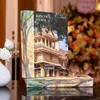Thich Tu Nghiem, a Buddhist monk at Pho Da Pagoda in the central city of Da Nang, has collected over 200 religious statues on his travels around the region.
Over the past 10 years, the collection has outgrown the 20sq.m room at the pagoda, which is filled to the brim with ancient works such as a 700-year-old copper casting of the Goddess of Mercy and a colossal sandstone statue from the 11th-century Champa Kingdom, where it originally guarded a temple.
"I try to pick up Buddha statues whenever I go for religious indoctrinations or study abroad. Because monks worship Buddha, searching for these statues is my way of paying respect to the deity," Nghiem said.
For the 55-year-old monk, the search has also been a personal journey. Each statue in the collection conjures up a specific memory.
Born into a family of six in the central city, Nghiem felt from a young age that he was fated to live a religious life. At the age of 12, inspired by a monk praying at his father's funeral service, he left his home to begin a new life at Pho Da Pagoda.
As a child, he collected Buddhist stamps. However, he later recognised the "beauty" of Buddha statues, and in the early 2000s he decided to embark on an ambitious search.
The first statue he found, while studying in Ho Chi Minh City, was the copper Goddess of Mercy.
"I had a dream of a Buddha statue, and I followed the dream to find this one in a house of a local man. He donated the statue to me because he thought it would be suitable for it to be placed at a pagoda," he said.
Since copper has a high melting point – around 1,000 degrees Celsius – sculptors typically use brass instead, so the lotus-flower emblazoned statue represents a rare work.
"Time has turned it black, but I want to keep it in the condition in which I found it," Nghiem said.
He pointed out a white glazed terra-cotta Buddha statue and explained it was discovered in the wreckage of a sunken merchant ship. He had gotten it from an antiques collector in HCM City, believing it might date from the age of the Kangxi Emperor of the Qing dynasty in China.
A statue of ascetic Arhat, made from a Tibetan ox's horn over a century ago, is another highlight of the collection.
"The Arhat statue is a real work of art," said Nguyen Van Ba, an antiquities collector in Da Nang. "It has far more detail than the ordinary statues of Arhat in pagodas. The dark brown colour of the ox's horn makes it a real beauty."
The collector was also quite impressed with the "huge variety" of statues, which includes 40 statues of the Goddess of Mercy alone, made of wood, silver, brass, copper and terra-cotta. The material for one statue - a Buddha head made from a block of metal - cannot even be identified.
"It's a mysterious statue," the monk said. "I would guess black brass, but I'm not sure."
The monk said he planned to open a gallery at the pagoda this year so visitors could see the collection. But he played down his role in bringing together the exhibition.
"The collection is a precious treasure; I'm just preserving it for the next generation," he said. "The statues may be expensive, but the history of each statue is priceless. I hope the collection will help younger generations explore the centuries-old culture and history of Buddhism." -V
Over the past 10 years, the collection has outgrown the 20sq.m room at the pagoda, which is filled to the brim with ancient works such as a 700-year-old copper casting of the Goddess of Mercy and a colossal sandstone statue from the 11th-century Champa Kingdom, where it originally guarded a temple.
"I try to pick up Buddha statues whenever I go for religious indoctrinations or study abroad. Because monks worship Buddha, searching for these statues is my way of paying respect to the deity," Nghiem said.
For the 55-year-old monk, the search has also been a personal journey. Each statue in the collection conjures up a specific memory.
Born into a family of six in the central city, Nghiem felt from a young age that he was fated to live a religious life. At the age of 12, inspired by a monk praying at his father's funeral service, he left his home to begin a new life at Pho Da Pagoda.
As a child, he collected Buddhist stamps. However, he later recognised the "beauty" of Buddha statues, and in the early 2000s he decided to embark on an ambitious search.
The first statue he found, while studying in Ho Chi Minh City, was the copper Goddess of Mercy.
"I had a dream of a Buddha statue, and I followed the dream to find this one in a house of a local man. He donated the statue to me because he thought it would be suitable for it to be placed at a pagoda," he said.
Since copper has a high melting point – around 1,000 degrees Celsius – sculptors typically use brass instead, so the lotus-flower emblazoned statue represents a rare work.
"Time has turned it black, but I want to keep it in the condition in which I found it," Nghiem said.
He pointed out a white glazed terra-cotta Buddha statue and explained it was discovered in the wreckage of a sunken merchant ship. He had gotten it from an antiques collector in HCM City, believing it might date from the age of the Kangxi Emperor of the Qing dynasty in China.
A statue of ascetic Arhat, made from a Tibetan ox's horn over a century ago, is another highlight of the collection.
"The Arhat statue is a real work of art," said Nguyen Van Ba, an antiquities collector in Da Nang. "It has far more detail than the ordinary statues of Arhat in pagodas. The dark brown colour of the ox's horn makes it a real beauty."
The collector was also quite impressed with the "huge variety" of statues, which includes 40 statues of the Goddess of Mercy alone, made of wood, silver, brass, copper and terra-cotta. The material for one statue - a Buddha head made from a block of metal - cannot even be identified.
"It's a mysterious statue," the monk said. "I would guess black brass, but I'm not sure."
The monk said he planned to open a gallery at the pagoda this year so visitors could see the collection. But he played down his role in bringing together the exhibition.
"The collection is a precious treasure; I'm just preserving it for the next generation," he said. "The statues may be expensive, but the history of each statue is priceless. I hope the collection will help younger generations explore the centuries-old culture and history of Buddhism." -V



















